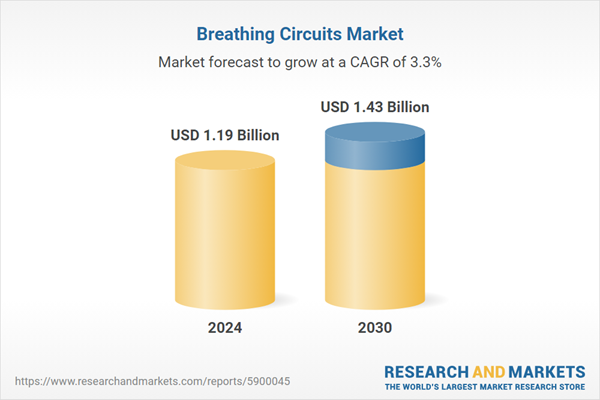Speak directly to the analyst to clarify any post sales queries you may have.
10% Free customizationThis report comes with 10% free customization, enabling you to add data that meets your specific business needs.
The growing global incidence of respiratory disorders and the increasing volume of surgical procedures have heightened the demand for reliable and efficient breathing systems. For example, the American Lung Association reported in July 2024 that 44.2 million Americans - 13.5% of the population - have asthma, reflecting a high burden on respiratory care infrastructure. The market continues to evolve with advancements in product design and the growing adoption of minimally invasive surgical techniques that require precise anesthetic delivery and airway management.
Key Market Drivers
Increasing Prevalence of Respiratory Diseases
The rising global burden of respiratory diseases is a key factor fueling the growth of the Breathing Circuits Market. Conditions such as COPD, asthma, and pneumonia are becoming increasingly prevalent due to factors including air pollution, aging populations, and tobacco use. Notably, the World Health Organization reported in November 2023 that China alone accounts for around 100 million COPD patients - approximately 25% of the global burden. This significant prevalence highlights the growing need for efficient respiratory care solutions. Breathing circuits are essential in managing these chronic conditions, ensuring the delivery of oxygen or therapeutic gases while maintaining a secure and functional airway. As demand for long-term respiratory support rises, the need for dependable breathing circuit technologies becomes more critical in both acute and chronic care environments.Key Market Challenges
Stringent Regulatory Compliance
A major challenge for the Global Breathing Circuits Market lies in navigating stringent regulatory frameworks that govern medical device development and commercialization. Regulatory bodies require high levels of product testing, quality control, and clinical validation to ensure safety and efficacy. These processes can result in extended development cycles and delayed product launches, especially for smaller manufacturers with limited resources. Additionally, as regulations frequently evolve in response to technological progress and new clinical standards, manufacturers must continually adapt - necessitating ongoing investments in R&D and compliance infrastructure. This regulatory burden not only adds to operational costs but also poses barriers to market entry and innovation, potentially slowing the pace at which new products reach healthcare providers.Key Market Trends
Rise in Minimally Invasive Surgery
The increasing adoption of minimally invasive surgical procedures is a notable trend driving growth in the Breathing Circuits Market. These techniques - such as laparoscopic, endoscopic, and robotic-assisted surgeries - offer benefits like reduced trauma, shorter hospital stays, and faster recovery. As such procedures become more common, there is growing demand for advanced breathing circuits that can provide precise, efficient delivery of anesthetic gases over shorter procedural durations. Tailored circuits designed for minimally invasive applications ensure accurate gas flow and patient safety, aligning with the needs of modern surgical practices. The broader shift toward less invasive interventions continues to reinforce the importance of reliable respiratory support technologies in surgical and perioperative care.Key Players Profiled in this Breathing Circuits Market Report
- Medtronic plc
- Ambu A/S
- Flexicare Medical Ltd
- Fisher & Paykel Healthcare Ltd
- Dragerwerk AG & Co.
- Hamilton Medical Inc.
- Armstrong Medical Industries Inc
- Meditera
- GE Healthcare Inc.
- Bio Med Devices Inc.
Report Scope:
In this report, the Global Breathing Circuits Market has been segmented into the following categories, in addition to the industry trends which have also been detailed below:Breathing Circuits Market, by Product Type:
- Open Breathing Circuits
- Semi Open Breathing Circuits
- Semi-closed Breathing Systems
- Closed Breathing Circuits
Breathing Circuits Market, by Application:
- Anesthesia
- Respiratory Dysfunction
- Others
Breathing Circuits Market, by End Users:
- Hospitals & Clinics
- Ambulatory Care Centers
- Others
Breathing Circuits Market, by Region:
- North America
- United States
- Canada
- Mexico
- Europe
- France
- United Kingdom
- Italy
- Germany
- Spain
- Asia-Pacific
- China
- India
- Japan
- Australia
- South Korea
- South America
- Brazil
- Argentina
- Colombia
- Middle East & Africa
- South Africa
- Saudi Arabia
- UAE
- Egypt
Competitive Landscape
Company Profiles: Detailed analysis of the major companies present in the Global Breathing Circuits Market.Available Customizations:
With the given market data, the publisher offers customizations according to a company's specific needs. The following customization options are available for the report.Company Information
- Detailed analysis and profiling of additional market players (up to five).
This product will be delivered within 1-3 business days.
Table of Contents
Companies Mentioned
The leading companies profiled in this Breathing Circuits market report include:- Medtronic plc
- Ambu A/S
- Fisher & Paykel Healthcare Ltd
- Dragerwerk AG & Co.
- Hamilton Medical Inc.
- Armstrong Medical Industries Inc
- Meditera
- GE Healthcare Inc.
- Bio Med Devices Inc.
Table Information
| Report Attribute | Details |
|---|---|
| No. of Pages | 185 |
| Published | May 2025 |
| Forecast Period | 2024 - 2030 |
| Estimated Market Value ( USD | $ 1.19 Billion |
| Forecasted Market Value ( USD | $ 1.43 Billion |
| Compound Annual Growth Rate | 3.2% |
| Regions Covered | Global |
| No. of Companies Mentioned | 3 |









